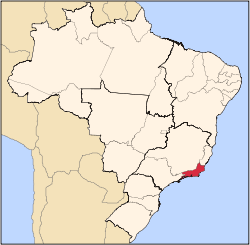Nilópolis
Coordinates: 22°48′28″S 43°24′50″W / 22.80778°S 43.41389°W
| Nilópolis | |||
|---|---|---|---|
| Municipality | |||
| The Municipality of Nilópolis | |||
 | |||
| |||
 | |||
| Coordinates: 22°48′19″S 43°24′55.91″W / 22.80528°S 43.4155306°W | |||
| Country |
| ||
| Region | Southeast | ||
| State |
| ||
| Founded | August 21, 1947 | ||
| Government | |||
| • Mayor | Alessandro Calazans (PMN) | ||
| Area | |||
| • Total | 19.157 km2 (7.397 sq mi) | ||
| [1] | |||
| Elevation | 14 m (46 ft) | ||
| Population (2012) | |||
| • Total | 157,986 | ||
| • Density | 8,200/km2 (21,000/sq mi) | ||
| [2] | |||
| Time zone | UTC-3 | ||
| Postal Code | 28000-000 | ||
| Area code(s) | +55 22 | ||
| HDI (2000) | 0.788 – medium[3] | ||
| Website | www.nilopolis.rj.gov.br | ||


Nilópolis (Portuguese pronunciation: [ˈnjilɔpʊˈʎiʃ]) is a city and a municipality in Brazil, located in the Rio de Janeiro state's southwestern region, bordering São João de Meriti, Mesquita and Rio de Janeiro. It is the smallest municipality in Rio de Janeiro state, with a total area of 19.39 km². The population of 157,483 inhabitants living in an area of 9 km² and the remaining area corresponds to the Gericinó's Natural Park. Officially, the population density exceeds 8,120 inhabitants/km², but if calculated just 9 km² occupied, it becomes the most densely populated city in Brazil with more than 17.400 inhabitants/km². Currently, the São João de Meriti have the highest population density, with 12,897 inhabitants/km².
Nilópolis was part of the hereditary captainship of São Vicente that belonged to Martim Afonso de Sousa in 1531.
Nilópolis is famous for its Grêmio Recreativo Escola de Samba Beija-Flor de Nilópolis, one of the most successful and luxurious Samba schools and usually a top contender for winning the carnival parade in Rio.[citation needed]
References
- ↑ IBGE link to check the area of every municipality of Brazil - IBGE
- ↑ "2012 Populational Estimate". Censo Populacional 2012. Instituto Brasileiro de Geografia e Estatística (IBGE). July 2012. Retrieved September 9, 2012.
- ↑ - UNDP
External links
- (Portuguese) Prefeitura de Nilópolis (Nilópolis City Hall)
- (Portuguese) Baixada Fácil (Nilópolis history)
| ||||||||||||||||||||||||||||||||||||||||||||||||||||||||||||||||||||||||||


